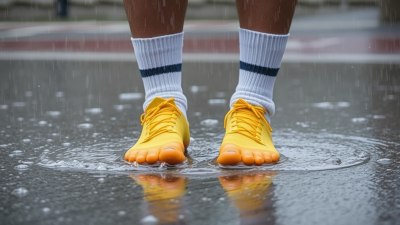How the Rain Targets Your Socks With Precision
Explore why rain so often soaks your socks and uncover tips to keep your feet dry during wet weather.

Rainy days bring a specific challenge that many people have experienced: no matter how carefully you try to stay dry, your socks often end up soaked. It seems like rain has a way of targeting this vulnerable part of your outfit with uncanny precision. This phenomenon isn't just bad luck but a combination of various factors that conspire to turn your feet into rain magnets.
Understanding why rain soaks your socks requires examining how water interacts with your clothing, how you move during rainfall, and how environmental conditions affect where and how water lands on your body. From puddle splashes to seeping water, the feet are uniquely susceptible to getting wet during rain events.
Why Socks Are the Most Vulnerable
The socks you wear are located in an area of high exposure to water during rain. Unlike your upper body, which is often shielded by jackets, umbrellas, or overhangs, your lower extremities are much harder to protect fully. Additionally, the ground near streets and sidewalks accumulates splashes and pools of dirty water that can soak right through typical fabric. Socks are semi-permeable, and most regular socks are not waterproof, allowing water to penetrate through easily.
Another reason socks get soaked is how much time your feet spend near or on wet surfaces. When walking in the rain, especially in urban environments, your shoes may pick up droplets, puddle water, or mud. Water can seep into your footwear if it's not waterproof or if you step into shallow pools. Even water-resistant shoes often allow some moisture to enter due to seams, wear, or inadequate coverage.
Once water has breached your shoe, it quickly penetrates the sock’s fibers. Cotton and wool, common sock materials, are absorbent, holding moisture close to your skin, leading to that unpleasant wet and cold sensation many dislike. The reason this happens so often is that shoes and socks offer the last line of defense, and many are simply not equipped for persistent wetness.
How Rain Targets the Lower Extremities
Rain falling from the sky comes down vertically but bounces and splashes on the ground, which is typically uneven and hard. When raindrops hit pavement or stone, they often rebound in unpredictable ways, splattering water in various directions — some droplets striking your lower legs and feet. This splash effect significantly increases the chance your socks will get wet even if your shoes appear to be dry.
Moreover, wind plays a major role during rainfall events. It can blow raindrops sideways, causing water to hit your legs and feet from angles you may not expect. This lateral rain is harder to avoid because it undermines the protection offered by coats and umbrellas, which mainly shield against vertical rainfall.
Another dynamic is walking pace and stride. When you walk briskly, your feet make contact with puddles more forcefully, causing more splashing. If you lift your feet too quickly or do not step carefully around wet spots, water is likely to splash upward and penetrate your socks. The shape and texture of your shoes can either reduce or amplify this effect.
The Role of Footwear in Sock Soaking
Footwear plays an essential role in determining your sock's dryness. Waterproof boots, rubber shoes, and properly sealed footwear can prevent water from reaching your socks, but these are not always comfortable or fashionable for everyday wear. Many people prefer sneakers or casual shoes that are less effective at repelling water.
Shoes that have mesh panels or are made from thin fabric tend to absorb water quicker and transmit it to the interior. Even leather shoes, which may appear water-resistant, can allow water entry if the stitching or seams aren’t sealed well. Over time, wear and tear also degrade waterproof properties, reducing shoe effectiveness against water.
The design of shoe soles can compound this problem. Flat soles without enough tread can cause more slipping and spreading of water, while deep treads sometimes trap pockets of water that eventually saturate the shoe interior.
Material Matters: Socks and Shoes Combined
Material choice impacts vulnerability to moisture. Cotton socks, despite being comfortable, absorb water almost immediately and stay wet for prolonged periods, increasing discomfort. Synthetic fibers like polyester or nylon dry faster but often don’t provide the same cushioning or warmth. Wool is a popular compromise because it retains warmth when wet and dries more quickly than cotton.
Pairing sock material with shoe properties is key. Using moisture-wicking socks within a waterproof shoe significantly improves dryness. Additionally, specialized waterproof or water-resistant socks have been designed for wet conditions, often made with layers that block water entry while allowing some breathability.
Environmental Influences and Behavioral Factors
Where you walk and environmental conditions also influence how likely your socks are to get soaked. Urban environments with concrete and asphalt increase splash effects, as rainwater cannot absorb into the ground and instead forms puddles or runs along sidewalks. Conversely, grassy or dirt paths absorb water better but can turn muddy, soaking footwear differently.
Behavioral factors like gait, stride length, and walking path adjustments affect water exposure. People who try to jump or step around puddles risk splashing water onto their legs and shoes. Those walking closer to curbs with passing traffic increase the risk of vehicle splash hitting their lower legs and feet, a common source of sudden sock wetness.
Technological Innovations in Waterproof Footwear
Advances in footwear technology have aimed to address these issues with innovative materials and design techniques. Waterproof membranes like Gore-Tex create barriers within shoes that prevent water penetration while allowing vapor to escape, keeping feet dry and comfortable. These membranes have become popular in hiking and running shoes to enhance moisture protection.
Seam sealing and water-resistant coatings are also widely used to reinforce shoe waterproofing. Some brands offer shoes with gusseted tongues, which prevent water entry through the lace area. Additionally, rubber or neoprene boots provide maximum protection for extremely wet conditions but may sacrifice breathability.
Practical Tips to Keep Socks Dry
Reducing the risk of wet socks during rain involves a combination of preparation, awareness, and appropriate gear. Carrying an umbrella helps but won’t protect your lower legs and feet entirely. Choosing waterproof or water-resistant shoes and moisture-wicking socks provides a significant advantage.
Consider layering socks or using specialized water-resistant over-socks that slip over footwear. When walking, avoid puddles and areas with obvious water pooling. Adjust your stride to minimize splashing and be mindful of passing cars that can splash water onto sidewalks.
At home or work, drying wet socks promptly is essential to prevent discomfort and potential fungal infections. Carrying an extra pair of socks for longer outings can offer a practical backup.
Psychological Perception of Sock Wetness
The sensation of wet socks often feels disproportionately unpleasant relative to the amount of water absorbed. Feet have numerous nerve endings making them highly sensitive. Wet, cold socks exacerbate this sensitivity, increasing awareness and discomfort. This creates a powerful psychological association between rain and sock soaking that feels almost intentional.
Understanding this heightened sensitivity encourages better prevention measures and realistic expectations about being outdoors on rainy days. People who prepare adequately for wet conditions report better comfort and reduced stress.
Conclusion: The Science Behind Rain's Sneaky Aim
The seemingly precise targeting of socks by rain results from a mix of environmental physics, human behavior, and clothing technology. Factors like splash dynamics, wind direction, footwear construction, sock materials, and walking habits combine to create an environment where feet are especially vulnerable.
Awareness of these influences and thoughtful clothing choices can significantly mitigate discomfort. Advances in waterproof technology combined with simple practical steps enable people to enjoy rainy weather more comfortably and keep their socks delightfully dry.
Ultimately, rain itself does not intentionally target your socks, but the interplay of natural forces and everyday actions makes it seem like it has an uncanny knack for doing so. Embracing this knowledge empowers better preparedness and reduces the unexpected nuisance of soaking your socks.











